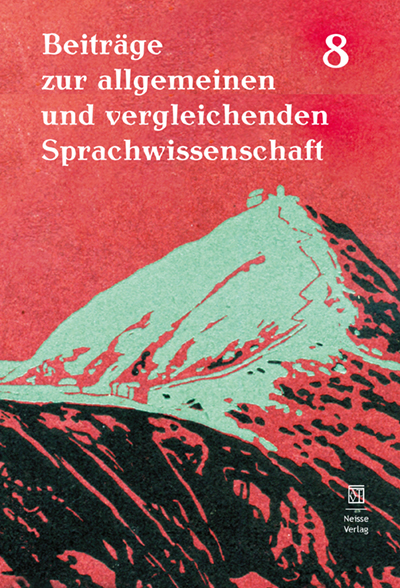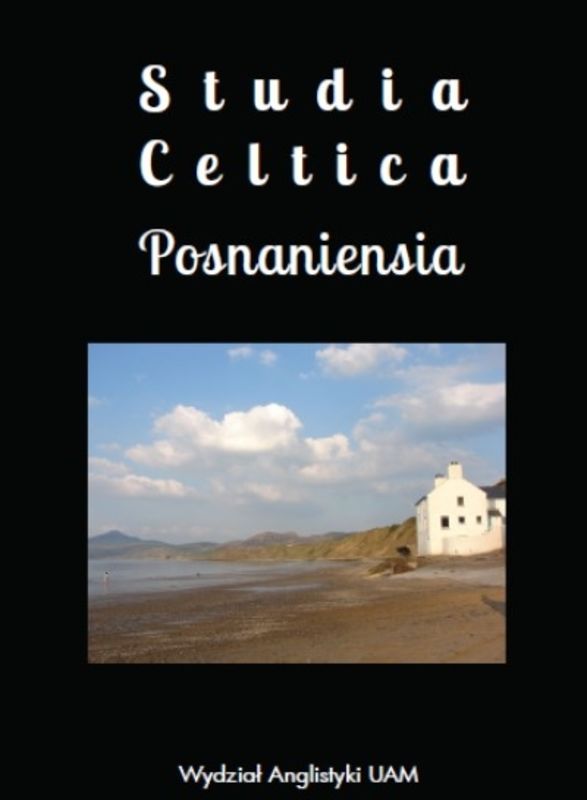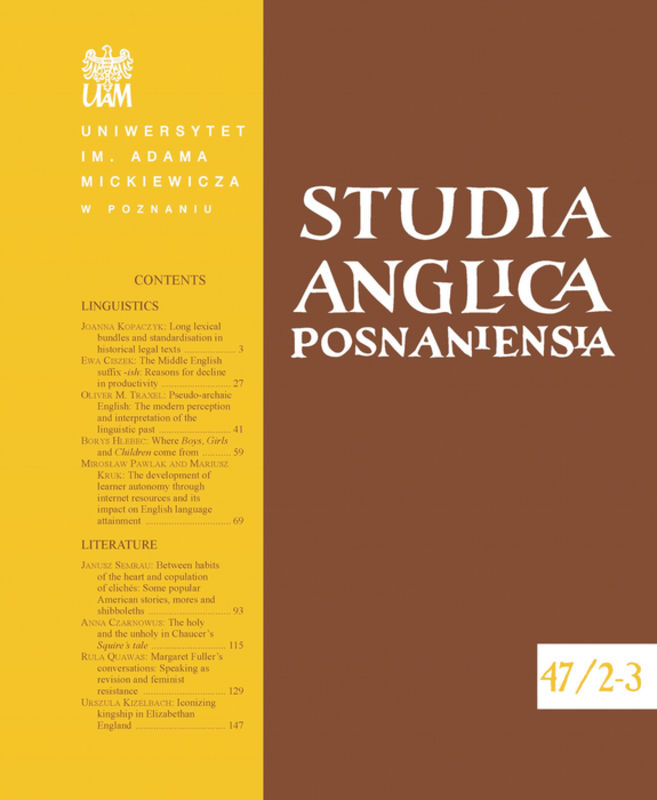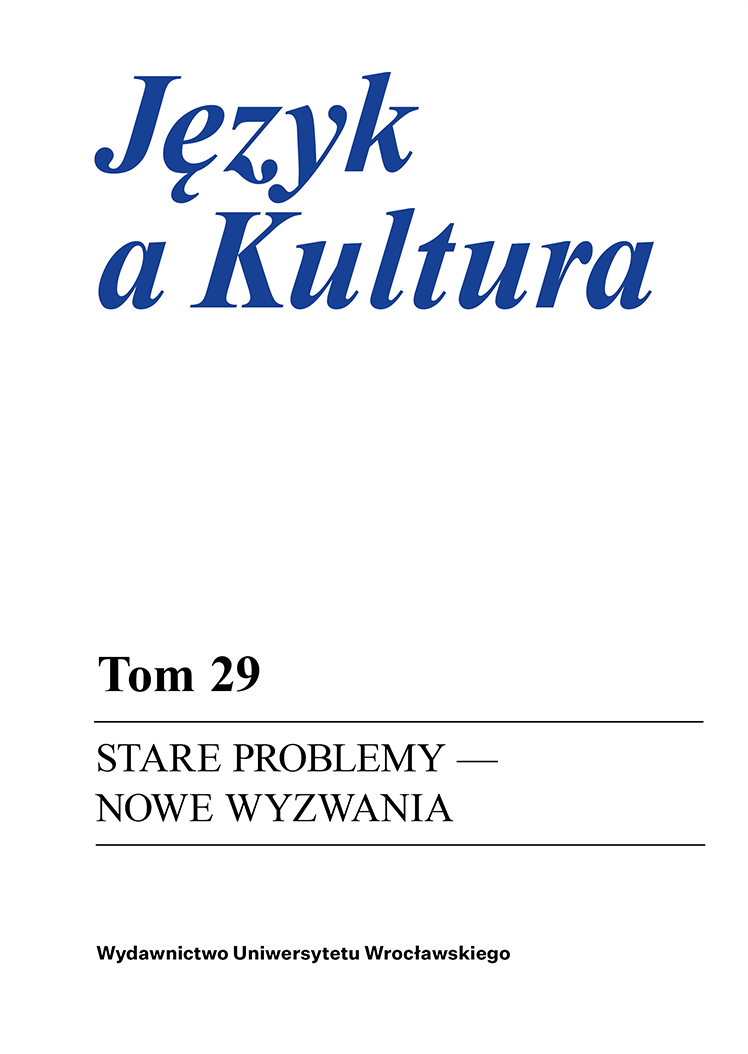
We kindly inform you that, as long as the subject affiliation of our 300.000+ articles is in progress, you might get unsufficient or no results on your third level or second level search. In this case, please broaden your search criteria.


The article researches the etymologies of one oikonym and one microtoponym used several times in Northern Bavaria. Traditionally they were said to have Slavic etymologies, but the 2015 PhD thesis by J. Andraschke (publ. 2016) claimed them to have German(ic) etymologies. The comparison of the different etymologies shows clearly that the Slavic ones are to be preferred over the decidedly weaker German(ic) ones. The names go back to CSlav. *Čьrnidel(ьnik)ъ and *Dolьnica respectively.
More...
The term keyword, created in 1954 by Pierre Guiraud, is also used in contemporary linguistics to describe words that, because of their frequency of occurrence, are characteristic of a particular text, the genre of a text or the writer's style. The indication of keywords defined in this way in Protestant funeral sermons, which are one of the most representative genres of German moralizing literature of the 16th and 17th centuries, is difficult and often does not provide an answer to the question of what is referred to in a given text. Based on the analysis of a sermon written by Johannes Bugenhagen on the death of Martin Luther (1546), the paper attempts to develop criteria for the selection of keywords in this genre of texts.
More...
The article hereunder presents the language analysis of a charter from 17th century titled “Wilkierz dla wsi klasztoru Panny Marji w Kartuzach” published by Stanisław Kutrzeba and Alfons Mańkowski in 1938 in Archiwum Komisji Prawniczej, volume 11. The text of an unknown scrivener was written in New High German in the Silesian dialect, what can be proved on the basis of the way of the notation in the law. The author introduces the results of his analysis showing the stage of the development of the consonant system with the appropriate examples.
More...
The paper constitutes part of a long-range series aiming, step by step, to identify the Afro-Asiatic heritage in the etymologically little explored lexicon of Omotic (West Ethiopia), a branch displaying the least of Afro-Asiatic traits among the six branches of this ancient macrofamily.
More...
In epic Greek both the optative and the indicative (the so-called “modal indicative”) can be used in contexts where the degree of realization is uncertain or even impossible, while in Attic Greek only the indicative is used. In these two articles I discuss whether there is a difference between the optative and the modal indicative in these contexts and/or if it can be determined which was the original mood. As there are about 1500 optatives and 250 modal indicatives in Homer, it is not possible to discuss them all and, therefore, I focus on the passages in which aorist forms of γιγνώσκω, βάλλωand of ἴδονappear, and those conditional constructions in the Odyssey in which the postposed conditional clause is introduced by εἰμήwith either a “modal” indicative or optative. The corpus comprises 100 forms (80 optatives and 20 indicatives), but in each example I also address the other modal indicatives and optatives in the passages, which adds another 50 forms to the corpus. In this part (part 2) I address the modal indicatives, and discuss the postposed conditional clauses introduced by εἰμήin the Odyssey, both in the indicative and the optative. Subsequently I analyze several instances in which the interpretation depends on the viewpoint of the hearer and the speakers, as what is possible for a speaker might be impossible for the hearer and vice versa. When comparing the data relating to the optative and the indicative, and especially that of the postposed conditional clauses introduced by εἰμή, it can be noted that the indicative has more frequently an exclusively past reference and that it is more often genuinely unreal than the optative, which often combines the notion of the possible, remotely possible and unreal. In my opinion this clearly indicates that the indicative eventually prevailed and replaced the optative because of the past reference.
More...
Guðbrandur Vigfússon, an Icelander born in Galtardalur, Dalasýsla, was without doubt one of the most influential scholars of Old Norse studies of his day. His diplomatic edition of Flateyjarbók, his critical edition of Sturlunga saga, and his anthology An Icelandic Prose Reader are still of use to those without access to the relevant manuscripts. In this essay, I would like to survey his career (in Copenhagen and Oxford) as an editor of Old Norse Icelandic texts and the legacy that he has left to his successors in the field of Old Norse studies.
More...
This paper seeks to examine the contexts in which the Old Irish law tracts were transmitted in the period following the church reforms and Anglo-Norman invasion of the twelfth century, focusing primarily on the fourteenth and sixteenth centuries. Within these time frames two major themes will be appraised: 1) the English attitudes towards the practice of Irish law, and 2) the roles of the medieval lawyers and/or their patrons in political life. The central aim of this paper is twofold; firstly to shed light on the historical and social contexts in which the legal materials were later transmitted, and secondly, based on this, to posit some theories as to the possible incentives behind the transmission of the law tracts in these periods.
More...
This paper deals with the long-debated question of the origins of tree names and the methodological problems related to PIE etymologies. It aims at putting forward some basic principles of etymology, and at applying these principles to the analysis of twelve tree names. It also seeks to demonstrate the relevance of substratic pre-IE languages’ influence on the lexicon, and at isolating geographic areas corresponding to pre-Indo-European lexical stocks lying behind modern Celtic languages.
More...
This paper aims to analyse the concepts of subjectivity and intersubjectivity in scientific writing through the use of stance adverbs perhaps and possibly. These adverbs act as markers of the authors’ presence expressing their views, and a covert relationship between these authors and their corresponding readership. The material used for this study includes four sub-corpora of the Coruña Corpus of English Scientific Writing: CETA (Corpus of English Texts on Astronomy), CEPhiT (Corpus of English Philosophy Texts), CHET (Corpus of English History Texts), and CELiST (Corpus of English Life Sciences Texts). Two of these represent the so-called soft sciences, and the other two the hard sciences, which will allow for comparison. The results might argue against the generally-assumed tendency in the history of scientific writing that this discourse has moved from being author-centred to object-centred. Perhaps it is simply impossible for writers of science to disappear completely from their texts.
More...
The article is a review and its aim is to answer the questions about which sections of historical linguistics are represented in the journal “Język a Kultura,” as well as which paradigms, directions, and research methodologies were used by the authors of the excerpted texts. The “Język a Kultura” journal, which has been published since 1988, has contained 73 historical and linguistic articles (which constitute 12.85% of all texts), representing such branches of linguistics as: semantics, lexicology, etymology, textology (genology), and linguistic pragmatics; to a lesser extent, the series covers grammar, dialectological and onomastic issues as well as language policy.
More...
Although the word qazaq is widely agreed to be the common ancestor of both ‘Cossack’ and ‘Kazakh’, there remains uncertainty about qazaq’s etymology. This paper proposes that qazaq originated as a variant of the central Turkic etymon qaç(g)aq and thus derives from the Common Turkic root qaç- (‘flee’). The paper draws on data generated through the traditional methods of historical linguistics—the comparative method and philological analysis—in conversation with recent work in anthropological and sociolinguistics on the concept of linguistic ‘register’ to better theorize qazaq’s historical development and the variation in its forms and meanings.
More...
The purpose of the article is to describe the conceptual characteristics of the victory concept in the XVIII and the XIX centuries. The research objectives are to analyze the dictionary entries for the world “victory” or other representatives of the concept in the explanatory dictionaries of the Russian and Church Slavonic languages and to trace the development of the conceptual characteristics of the victory concept based on the data obtained. The relevance of the research lies in understanding the evolution of the primary signs of the studied concept and to the class of conceptual characteristics. There are no studies that analyze the conceptual characteristics of the victory concept in the XVIII and the XIX centuries, which determines the research novelty. Forty-two conceptual characteristics of the victory concept were identified during the analysis of five dictionaries of the said period. Ten characteristics not found in the dictionaries proved to be relevant for the period under study. This was confirmed by data from the Russian National Corpus. Overall, there were revealed 52 conceptual characteristics over the studied period.
More...
The present study uses qualitative methods to analyze and restore an invented missionary writing system for the Shanghainese language, and uses the restoration to check for historical sound change. The project consists of two parts: the analysis and restoration of the orthography and the confirmation of historical sound changes in Shanghainese. The restoration of the writing system provides all symbols with equivalent International Phonetic Alphabet (IPA) symbols. Following the restoration to IPA is an explanation of the rules for combining initial and final symbols to form a single character, as well as rules for tonal distinction. The analysis of the restored orthography compares its development with the academic criteria for orthography development, and finds that it is a sound writing system. The evaluation also reviews the sociolinguistic criteria crucial for orthography acceptance, and shows that the writing system does not meet these criteria in present day Shanghai. The results of the check for historical sound change confirm that many of the sounds not found in present day Shanghainese existed in this writing system. The phones found in this writing system are able to confirm the disappearance or merger of various sounds in Shanghainese since the mid 19th century. Overall, the study shows that the invented writing system is sound, but would not be accepted in Shanghai today. However, it should be reviewed by other linguists as having the possibility to represent other languages.
More...
The paper examines the sources quoted in Mátyás Gyóni’s study on the history of the Byzantine thema Paristrion in the 11th century and on the ethnonyms used in the Alexias, adopting a new approach. Tracing the history of the word μιξοβάρβαρος from the classical era on, it states that the adjective was originally used to describe the (Greek and barbarian) inhabitants of the settlements situated in the border area of the Greek world, then to refer to a language different from the literary (Attic) Greek, linguistic phenomena or persons to be avoided and (morally) despicable, and finally to denounce an unorthodox (especially iconoclast) Christian. The 11-13th century Byzantine authors also used the adjective for denunciation. However, at the classical locus in Michael Attaleiates the adjective is neutral, used the same way as by two classical authors (Plat. 245d, Xen. Hell. 2, 1, 5), with the difference that mixobarbaroi (ODB s. v.) refers not to the inhabitants of a single town, but to the mixed population of a certain area, (the towns of) Paristrion. Anna Comnena’s usage in the Alexias is unique as there the most important characteristic of a μιξοβάρβαρος (probably from a mixed marriage) is that he is bilingual.
More...
This contribution analyzes the geographical name Θούλη, first recorded by Pytheas of Massalia in the period 330-325 BCE and mediated especially by Polybius, Strabo, Pliny and Procopius. Björn Collinder (1935/1936) designated this term as the earliest datable document of the Germanic Lautverschiebung. He also offered an appealing etymology, explaing the toponym on the basis of Old Norse þaularvágr “winding creek”, i.e. a place especially characteristic of the West Norwegian coast with its winding fjords. In the present study an alternative etymology by Torp is also analyzed, interpreting the toponym as a wooded place with regard to Old Norse þollr m. “tree, fir-tree, pine-tree”, and the witness of Procopius of Caesarea on the exceedingly large forests in Thule [‘The Gothic War’ VI.15]. Independently of whether either of the solutions of Collinder or Torp is correct, around 330 BCE the First Germanic Sound Shift should already have been operating.
More...
In this paper, I present a novel corpus investigation of quantified and negated objects in the Middle English and Early Modern English period, which is embedded within the wider language change scenario from linear OV to linear VO in the history of English. It will be shown that evidence for preverbal positioning of such objects is mostly limited to translated texts in Middle English in the PPCME2 corpus, and that by late Middle English, most of the hits consist of negated elements, as shown in the PCEEC corpus, which consists of native texts. The different constraints governing spell out of positive objects in Old English and Middle English are discussed and compared to the licensing of negated and quantified objects. The data provided in this paper constitute further evidence for Ingham's (2000, 2002, 2007) analysis of preposed negated objects in late ME and their correlation with the Negative Cycle, and complement previous investigations on negated and quantified objects in Middle English and Early Modern English.
More...
This paper explores the problem of the source value of charters from the point of view of research in linguistic history. Charters written in Latin often contain elements of the vulgar language (in this case, Hungarian). Only four authentic Hungarian charters have survived from the 11th century in their original form. Therefore, we have also included the non-authentic and non-original charters of the 11th century in our research over the recent decades. These charters may contain 4–5 chronological layers, and so our task is to separate them. Charters of uncertain status cannot be analysed using the same methodological principles as the authentic and original charters. This paper discusses the methodological principles that may facilitate the identification of the source value of these charters for historical linguistics. Although these principles are defined based on charters from Hungary, due to their universal nature a significant portion of them may also be used successfully in other regions of medieval European charter research.
More...
Inscriptions in the highly calligraphic and still undeciphered śaṅkhalipi or ‘shell script’ have been found by the hundreds in most parts of India except the far south, typically in conjunction with sites and monuments dating from around the Gupta period and succeeding centuries. To date, four specimens have also been discovered in the Indonesian archipelago, in West Java and West Kalimantan (Borneo). Another specimen of śaṅkhalipi inscription, engraved on a pillar and exceptionally ornate, was recently discovered in Thailand at the site of Si Thep, a moated early settlement in Phetchabun Province. The article reviews the historical and cultural contexts of shell-script inscriptions in India and discusses the significance of this remarkable first specimen found in mainland Southeast Asia.
More...
Aurea mediocritas: Heroes and Fake Heroes/Antiheroes in Romanian Hodonymy. Specialised literature has shown that, regardless of geographical space and historical era, authorities have sought to honour heroes and grant them “immortality” by giving their names to various roadways: streets, boulevards, squares. From a socio- and psycholinguistic viewpoint, there is the issue of associating positive or negative values with the given figures depending on the political regime. Those who are seen as heroes at one point in time can be considered war criminals at a different moment in history. Similarly, the heroes of a certain nation can be the sworn enemies of a neighbouring people. Therefore, a theory of values needs to be advanced, a balance in judgement that should be above the circumstantial interests of those in power. This study analyses Romanian hodonymy from the aforementioned perspective. Since the officialization of street nomenclature, Romanian hodonyms have been subjected to several processes of street-name changes, determined by the unification of the country, the world wars, the various stages of the institution of the communist regime, and the establishment of democracy after 1989. Names of streets and squares are eloquent markers of all the onomastic changes that have occurred in Romanian space over different historical periods.
More...